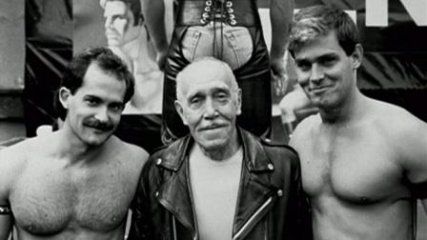I wanted to correct the injustice of real life through fantasy.

To follow Black White + Gray, I trooped down to Plan Nine to rent another documentary about a gay artist who rose to prominence in the '70s and '80s and whose impact is still being felt today: Tom of Finland. Directed by Ilppo Pohjola, Daddy and the Muscle Academy benefited from having been made in 1991, when Tom (real name: Touko Laaksonen) was still alive and more than happy to sit down and talk at length about his life and career. Pohjola got to him just in time, though, because the 71-year-old artist died just a few weeks after the film's Finnish premiere. At least this means the 55-minute film gets to spend the entirety of its running time celebrating the man's work as opposed to mourning his passing.
In addition to the interviews with Laaksonen, who is remarkably sharp and eloquent, and depictions of his erotic art, Pohjola brings a number of his fantasies to life, most enticingly in the opening sequence, which finds the camera roving around a dark space inhabited by shadowy figures dressed in all kinds of gear. In between Laaksonen's recollections of the time his parents gave him a pair of brown leather boots (thus igniting a lifelong obsession), fighting in World War II (when he developed his interest in uniforms), his day job at an ad agency (a vocation also shared with Sam Wagstaff), and getting his drawings into print (something that didn't pay much in the early days), Pohjola inserts cutaways to the "types" he drew in his spare time. There's the muscle man oiling himself up and showing off his physique, the burly, mustached sailor, the leather man getting leathered up and shining his boots, another shaving himself down to his Tom of Finland-inspired sideburns, and one who dons a police uniform. There's also a long tracking shot exploring Laaksonen's unpretentious studio, where he continued to work right up until the end. (We see him using a live model in the film, but more often he chose to work from photographs, which gave his pieces a sense of realism -- once you look past the exaggerated body parts.)
To get a sense of how much of an impact Laaksonen's life-affirming, overwhelmingly sex-positive work had on the gay community, Pohjola includes interviews with artist and critic Nayland Blake, Tom of Finland Foundation co-founder Durk Dehner, and erotic artist Etienne, and illustrates his influence on Robert Mapplethorpe's photography and Rainer Werner Fassbinder's Querelle. He even digs up black-and-white footage of the packed opening of Laaksonen's first gallery show in New York in 1978, which Mapplethorpe was present at. Lastly, there are the unnamed leather men who responded to his art by emulating what they saw there, forging their own identities in the process and becoming, in effect, "Tom's men." They may not be as numerous as they once were, but as long as Tom of Finland remains in print, there will always be some of his men around.